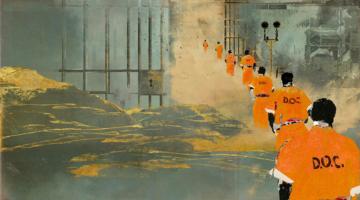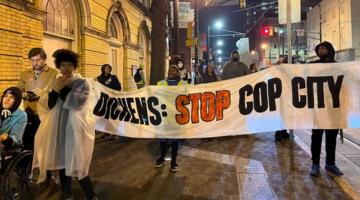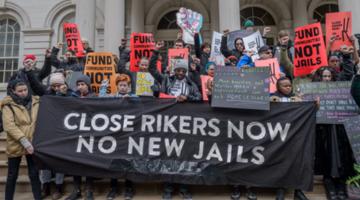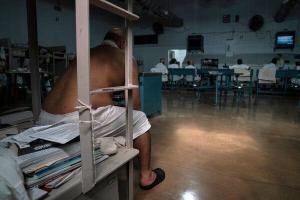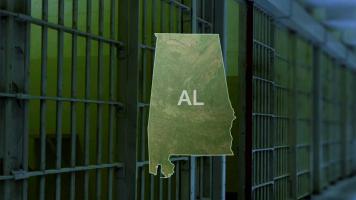The prison system links corporate interests, the military industrial complex, and policing into a web of oppression impacting more than 2 million people in this country. The Mapping Project reports on incarceration in Massachusetts.
“The explicit function of prison is to separate people from society, and this costs money”
- Ruth Wilson Gilmore
The contemporary US prison system incarcerates people — largely Black, Native, Latinx, disabled, and working-class and poor folks — and hides them from society for years, decades, or lifetimes. This is true across the United States generally and in Massachusetts, specifically. These days, when discussing the case against incarceration and the prison system, there are a few different arguments one tends to hear: (1) the first is that incarceration is immoral and reprehensible in both its conditions and treatment of incarcerated people; (2) a second, appealing to economists and technocratic policymakers, argues that prisons are a drain on taxpayer dollars and the money wasted there would be better spent on social services and alternatives; (3) another argument that centers racialization is that the prison system is a direct continuation of chattel slavey, chain gangs, and Jim Crow forced labor; (4) a final common refrain is that degenerate investors in private prisons and detention centers, as well as other perpetrators of gross injustice live off of turning prison labor into private profit.
All these arguments are valid, but all too often, we hear just one or two in isolation in efforts to appeal to the conscience or purse strings of varying sectors of the liberal political establishment. For example, much outcry has been made recently about the inhumanity of prison labor, especially at prisons like Angola in Louisiana, where conditions resemble the days of chain gangs or chattel slavery. Nonetheless, focusing on such spectacular cases obscures the reality of abuse and exploitation inherent in the entire prison system, which is itself just one dimension of capitalist-imperialist-patriarchal domination.
More specifically, this narrowing of focus often reduces the injustice and exploitation of the US prison system to its most egregious violations, hiding the more insidious reality that the entire system is simultaneously a social and political weapon managed by the government and an industry fueled by the routine interests of capital and its corporate jackals – all deeply intertwined with the larger goals of US empire.
In mapping the complex web of oppression and economic extraction that is the prison industry and its supporting institutions, we must remember that our goal is to not only expose and defeat individual egregious ‘bad actors’ or single corporate profiteers, but to dismantle the system as a whole. Long before the Mapping Project, abolitionist groups have taken a holistic approach that combines the short-term goal of stopping visible actors with the long-term strategy of disrupting the expansion of the PIC more broadly. Local abolitionist group Families for Justice as Healing (FJAH), for example, is not only conducting coalition-based campaigns against firms like HDR architecture that claim to bring a ‘restorative justice’ and ‘trauma-informed’ approach to their lucrative prison-building activities, but is also mobilizing to stop the construction of prisons altogether and free women from prison in Massachusetts.
Geography & intentional obscurity of the prison system
In understanding and organizing against the prison-industrial complex (PIC), it is crucial to remember that incarceration, policing, and mass surveillance, are materialized in geography — a fact that enables corporate actors, and the entire system, to hide in plain sight. Ruth Wilson Gilmore, the renowned geographer and abolitionist, has written about this extensively, as have many others, including Katherine McKittrick, who explains the geographic and psychic dimensions of the prison-industrial complex: “relegating prison life to the margins naturally condemns the incarcerated while providing those outside and/or seemingly disconnected from this system to point to the dispossessed without touching the dispossessed, or, more dangerously, simply view incarceration as indicative of ‘natural’ life cycle and the unsurvival of the weakest.”
While the prison system is all around us, by design its operational management, economic lifeblood, and imperialist links are hidden if we are not paying close attention. This phenomenon of relegating prison life to the geographic and psychological margins of “mainstream” society serves the dual purpose of normalizing the dispossession, exploitation, and abuses of the carceral system, while absolving those of us on the “outside” of the potential discomfort or guilt of having to see those who are being punished for society’s inability to address fundamental social, economic, and political problems. This dual purpose of normalization and absolution supports the ongoing tide of incarceration and marginalization through the PIC. But though this tide is forceful, it is not inevitable, and organized communities and movements can stop its continuation – but we must have the awareness, knowledge, and relationships to fight against each head of this hydra.
These heads, or entities, are often recognizable, with headquarters and offices in major metropolitan areas like Boston, and employees and customers that often do not know that part of their pay and products are built off the incarceration of mostly racialized, disabled, working class and poor people. They include many corporations directly linked to the prison system, as well as universities and nonprofits who typically have more indirect linkages (like contracting well-known prison profiteer Aramark as a food service supplier). This is why advocates like Worth Rises, a NY-based nonprofit organization, are so adamant that we understand and fight against the ‘prison industry’ as a whole: because the system sustains and expands itself through corporate capture of public funds, ongoing extraction of wealth from incarcerated peoples’ families and loved ones, and predation of Black and Brown communities.
For this reason, it is imperative that we expose the linkages through which the systems of incarceration (prison, jails, immigration detention centers, juvenile detention facilities, etc.) throughout the state and the country are upheld and expanded. Prison facilities themselves may often be physically far from urban cores, but we must bring the connections that sustain their exploitation and abuse to the center of our analyses and conversations. The first iteration of the Mapping Project takes a step towards doing just this.
Mapping the prison industry in Massachusetts
In this initial iteration of the mapping project, we have shown a few of the key linkages that connect entities involved in the Prison-Industrial Complex in Massachusetts, which include project contracts between “corrections” facilities and architectural/engineering/design firms, ongoing supplier relationships with prisons and police, financial investments in incarceration and surveillance, and more. The map is currently centered around a few prisons and jails (and for now excluding other detention facilities): MCI-Framingham Prison, Middleton Jail, and Suffolk County Jail; Aramark, a multi-billion dollar servicer of both prisons/jails, universities, and other corporate entities; and the various design and construction firms that feed off taxpayer dollars being used to criminalize and cage people in the state (notably HDR Architecture, Kleinfelder Northeast, and Finegold Alexander & Associates).
 https://lh5.googleusercontent.com/rtpg-3moVQAhoV5DwqQbMTxr9-N4xWc6DhUeMCqnL-Dl7ORTd1wJEDmnKuGEcE5_j4PETpyrx83NhuJJTtm1_AntU78JTSDoL9It_GSY4515MS1naT1QP59xdNHY12DmAYPw54zo_u6Z8hzpVg">
https://lh5.googleusercontent.com/rtpg-3moVQAhoV5DwqQbMTxr9-N4xWc6DhUeMCqnL-Dl7ORTd1wJEDmnKuGEcE5_j4PETpyrx83NhuJJTtm1_AntU78JTSDoL9It_GSY4515MS1naT1QP59xdNHY12DmAYPw54zo_u6Z8hzpVg">
Geographic view of prisons/jails (in orange) and Massachusetts entities directly complicit in PIC harm
 https://lh5.googleusercontent.com/67eGz7f0yg6kb0Zx6M52V_BReW2RDx-Nl-E5UnmQY8PRY-_-7l5-lS_uewHElAl3n60wWS1alkbM9UUeuvnVuWVTnwFRUQ0j_ShIiZSc25IIRiQs0KgDO5PXyN_N-W5uT88H8Bh6uNuKU4tsNg">
https://lh5.googleusercontent.com/67eGz7f0yg6kb0Zx6M52V_BReW2RDx-Nl-E5UnmQY8PRY-_-7l5-lS_uewHElAl3n60wWS1alkbM9UUeuvnVuWVTnwFRUQ0j_ShIiZSc25IIRiQs0KgDO5PXyN_N-W5uT88H8Bh6uNuKU4tsNg">
Graph view of current connections between core PIC entities (MCI Framingham, Middleton Jail, Suffolk County Jail, Aramark, Noresco, Guardian Uniform and Supply, TriMark) and their corporate and academic linkages
And though private prisons are part of the problem and receive a disproportionate amount of attention, most prisons and jails are government-owned and operated. This means that the bill for prison construction and operations is footed by taxpayers, who are effectively subsidizing the corporate entities that feed on the captivity and exploitation of incarcerated peoples. For these private firms, then, enabling and expanding the incarceration of racialized and disabled and working class and poor people is good, stable business, and they have been relentless in their pursuit of government contracts, just as the state has continued to seek more facilities in which to incarcerate its ‘surplus’ residents.
The infrastructure and profiteering within the prison-industrial complex in Massachusetts, however, extends far beyond the architecture, engineering, and construction firms that have recently come under scrutiny.
According to Worth Rises, which, among many other activities, details the private corporate actors that make up part of the prison industry, as of 2020 there are at least 89 unique Massachusetts-based companies that have generated revenue from the prison industry, whether through construction/design, providing equipment and services, investing in prison construction/maintenance/operations, or a myriad of other sectors seen below:
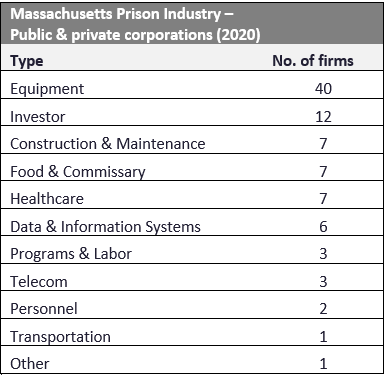
The Mapping Project currently contains a subset of these companies and will continue to add more over time. As the current visualization and data from Worth Rises shows, these PIC corporations span many sectors and touch just about every aspect of economic life in the state. Though many of these prison industry companies’ contributions may seem benign, such as New Balance’s supply of apparel and equipment, the everyday “business-as-usual” activities of these corporations is what sustains captivity and exploitation.
In the case of Raytheon, this means deep crossover between imperialism, militarization, and immigrant detention. Based outside of Boston, Raytheon is the world’s second largest weapon company, and not only supplies missiles for aerial assaults on civilians in Palestine and Yemen, but also provides US Customs and Border Patrol with equipment to track Black and Brown migrants near the US-Mexico border. Specifically, the company made $45 million between 2008-2021 on these contracts with the CBP. Beyond this, Raytheon has in the past sold torture equipment intended for US military imperialist actions abroad to US-based prison/jails. As if this weren’t enough, Raytheon, along with 16 of the top 25 largest weapons companies, also uses prison labor to directly manufacture some of its weapons and war technologies – another clear link between domestic incarceration and war imperialism.
Another ‘big name’ prison profiteer, Fidelity Investments, is based in Boston and is one of the largest fund managers in the country. They hold over $340 billion in assets in companies involved in the PIC, and over $23B in ‘high risk’ PIC assets – over 16% and 1% of the company’s total US-based equity funds, respectively. Given Fidelity’s prominence as a retirement fund manager, this means that it is highly likely that the retirement accounts or mutual funds that a large portion of individuals and institutions are using to plan for the future are also embedded in the prison industry (see Prison Free Funds for a rating of 317 specific Fidelity funds).
Confronting the prison industry locally and nationally
As referenced above, Families as Justice and Healing (FJAH) is a grassroots organization based in Roxbury, MA that was founded by Andrea James while she was incarcerated in a women’s federal prison, and began working on the outside when she was released in 2011. Centered on the needs and experiences of incarcerated and formerly incarcerated people, the organization works to end the incarceration of women and girls through organizing, advocacy, participatory defense, and transformative justice processes. FJAH and its partners recently made the following demands on the architecture firm HDR, Inc., which show how we can confront the PIC’s profiteers: (1) pulling out of all current jail/prison/detention center projects, (2) committing to no longer designing the facilities, (3) committing to working with directly impacted people to design infrastructure that can repair harm of HDR-designed facilities, and (4) challenging other industry leaders to divest from jail and prison construction.
Though these demands are specific to one firm, they model what it means to pressure the prison industry profiteers in our midst. It is not a liberal call to create so-called “trauma-informed” prisons, but a demand to stop supporting the prison industry and to help repair the harms already caused. FJAH runs several other programs and campaigns designed to dismantle the prison industry and broad ecosystem of policing and incarceration, particularly through their Re-Imagining Communities work, which aims to develop community-led alternatives to harm and shift public resources towards investment in Black and Brown communities.
Combatting the overlapping oppressions and exploitations that abound within the PIC, military-industrial complex, finance and banking, and other sectors requires this type of systematic strategy. It requires radical organizing in collaboration and solidarity with the combined short- and long-term strategies that local organizations like Families for Justice as Healing are engaged in – because in order to see a world free of oppression and full of self-determination and dignity, we must organize far and wide against the harms of US empire at home and abroad, from Boston to Ferguson to Haiti to the African continent and around the globe.
Looking forward: Dismantling imperialism and the PIC
Building on the work of abolitionist and anti-imperialist organizers, our analysis of the networks that sustain and profit from incarceration while continually harming communities, forces us to confront the local dimensions of imperialism. This systemic perspective can hopefully enhance our understanding of what it will take to abolish the PIC in Massachusetts and move towards dismantling imperialist capitalism locally and beyond.
While we continue to conduct research and inform our communities of who is benefiting from their exploitation, we should remember this fact: prison is a lucrative industry for many corporations and government contractors, but that is just one dimension of the broader purpose of prison within US empire, which is to socially control, politically repress, and psychologically defeat individuals and communities through a racialized and class-based system of captivity. As we work to continue building awareness about the linkages that make up the prison industrial complex, we must never lose sight of this understanding.
[1] McKittrick, K. “On plantations, prisons, and a Black sense of place.” Social & Cultural Geography, Vol. 12 No. 8. Dec 2011
[2] Worth Rises “The Prison Industry: Mapping Private Sector Players”. 2020. https://worthrises.org/theprisonindustry2020
[3] “Fidelity Investments,” Prison Free Funds.
[4] “HDR No New Prisons Demand Letter” from FJAH and allied groups
[5] FJAH website: https://www.justiceashealing.org
The Mapping Project "We are a multi-generational collective of activists and organizers in eastern Massachusetts who wanted to develop a deeper understanding of local institutional support for the colonization of Palestine and harms that we see as linked, such as policing, US imperialism, and displacement/ethnic cleansing. We are unpaid and don’t report to any donors."

